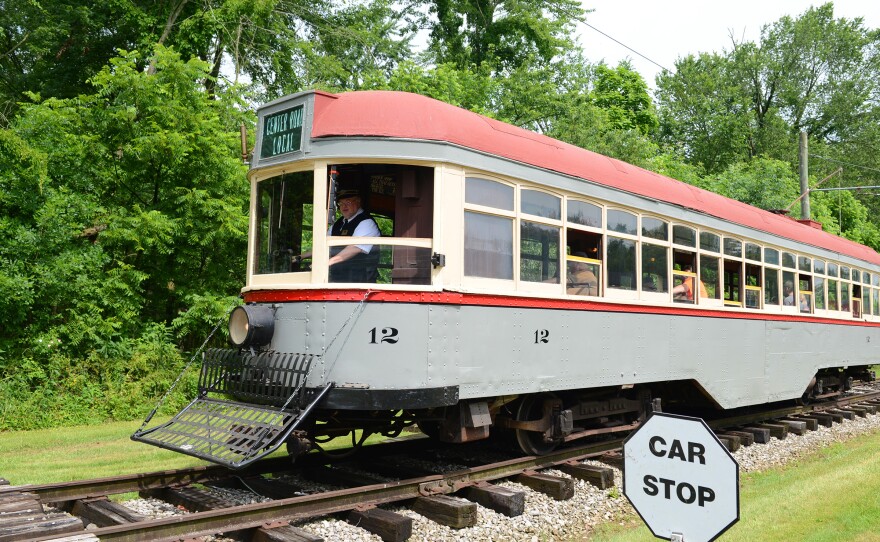Not far from where automobiles zip down a busy Interstate Highway 71, a museum dedicated to a different era of transportation is tucked away on 63 acres south of Chippewa Lake in Medina County.
Every year from May to September, the Northern Ohio Railway Museum welcomes visitors on a journey back to a time when electric streetcars were the way people traveled around towns and cities.
“Why do we have a canal boat museum? Why do we have an art museum? There's a certain segment of life that needs to be saved,” said Walt Stoner, one of the museum’s founders. “And we’re the trolley guys.”
But this isn’t the kind of museum where photographs and artifacts are on display behind glass. Guests can walk through two large car barns that house part of the museum’s collection and get up close with trolleys that once traveled along a vast network of tracks throughout Northeast Ohio.
The museum, affectionately called NORM like a man’s name, has about 150 members and volunteers that keep the place running and share their enthusiasm for transit history.
“We have walking tours in the museum,” Stoner said. “A docent will take you around and probably tell you more about the cars than you want to know.”
In one barn, an area is dedicated to restoration, where volunteers work to restore cars to their former glory.
“We've had several cars we've restored and are in use, one way or the other, and a couple more that are waiting,” Stoner said.
Two cars in operating order welcome the public to hop aboard for a trip along the mile-long track that winds through the property. On the second and fourth Saturdays during the summer months, rides are offered with a history lesson from the conductor on board. It’s an experience that draws smiles from young and old alike.
"The real little ones, sometimes they'll hold back a little bit because, 'Wow, this is a big thing making noise at me,'" Stoner said. "Once they're in there, they're waving and having a ball."
The early years
When he was a young boy growing up in Warrensville Heights, Stoner would watch trains going by on the tracks near his home.
“There's just a certain lure of trains that attracts you. At least it attracted me,” he said. “As a little kid, I always wanted to go for a trolley ride or a train ride.”
In the early 1960s, he was an avid model railroader while working as a mechanic in his father’s gas station. His path crossed with two other rail enthusiasts, Lee Smith and Anson “Red” Bennett. Together they founded the museum in 1965, when Stoner was 22 years old.

A collection that started out with one former interurban car – interurbans were rail cars that connected suburban and rural communities to larger cities – continued to grow over the years, and so did the amount of land required to house it all. Where the museum sits now is on land adjacent to a two-mile stretch of the former Cleveland, Southwestern and Columbus Interurban right-of-way.
By the mid-1970s, major changes were taking place within the area’s transportation system, with the former Shaker Heights Rapid Transit and Cleveland Transit System consolidating to form the Greater Cleveland Regional Transit Authority.
In the years following, the RTA began replacing nearly all its rail cars and 21 retired cars made their way to NORM, boosting its collection from 11 to 46 rail cars by the end of the decade.
Preserving history
It was during the ‘80s, a period of immense growth for the museum, that Steve Heister came on board as a volunteer. More than 40 years later, he’s still very involved in day-to-day operations and now has more time to devote to NORM after recently retiring from a career as a TV broadcast engineer in Cleveland.
He also loved model trains as a kid, an interest that never went away.
“Then I decided I liked the real thing, so I started taking pictures of the real things,” Heister said. “That got me into photography, which led me into my vocation of eventually working in television.”

With his camera, Heister has helped document the history of the museum throughout the years, photographing the restoration of several trolleys and deliveries of “new” cars arriving to the collection. He also has vast knowledge of NORM’s photo archive that contains nearly 100,000 historic images.
Though he wears many hats – he also assembles a newsletter every other month for members and manages communications – his favorite hat is the one he puts on when he steps aboard a restored 1914 trolley car to take visitors on a ride.
“I like to ring the bell and blow the whistle,” Heister said. “I just like running cars, it’s fun. And then just turning around and looking at the joy on people’s faces as they’re taking a ride. I like watching those moments happen.”










